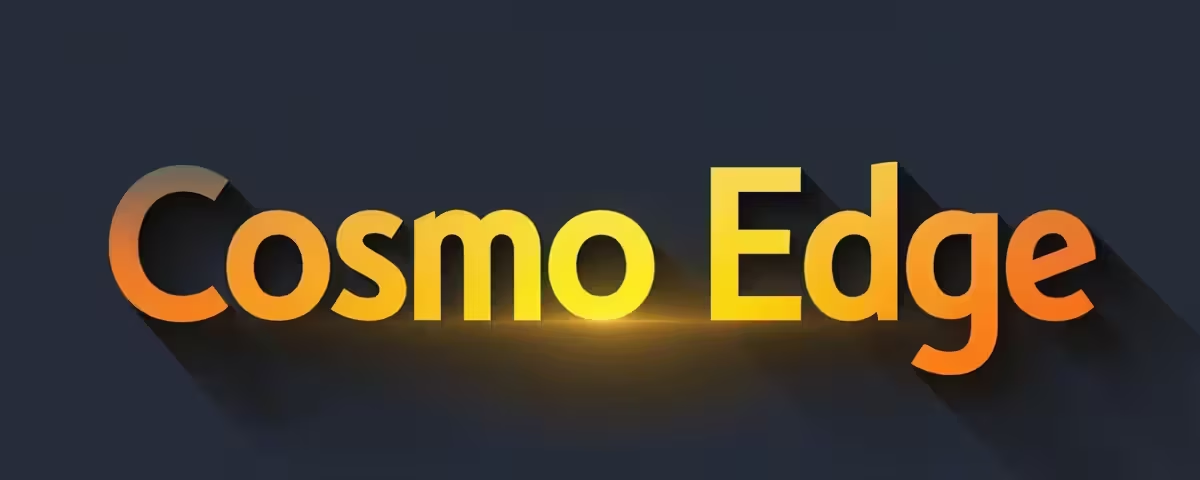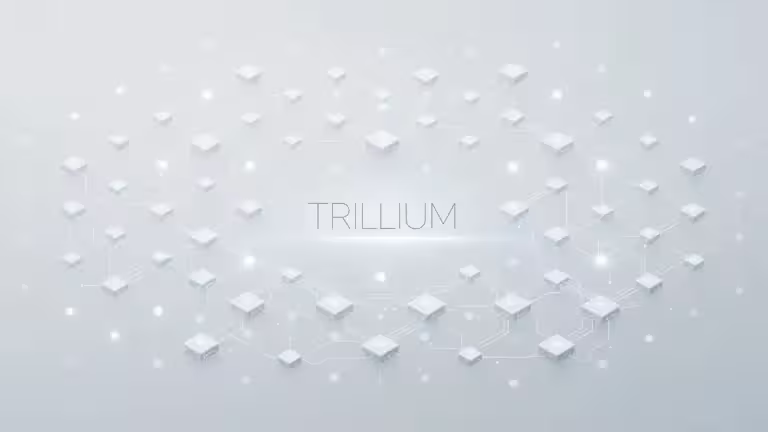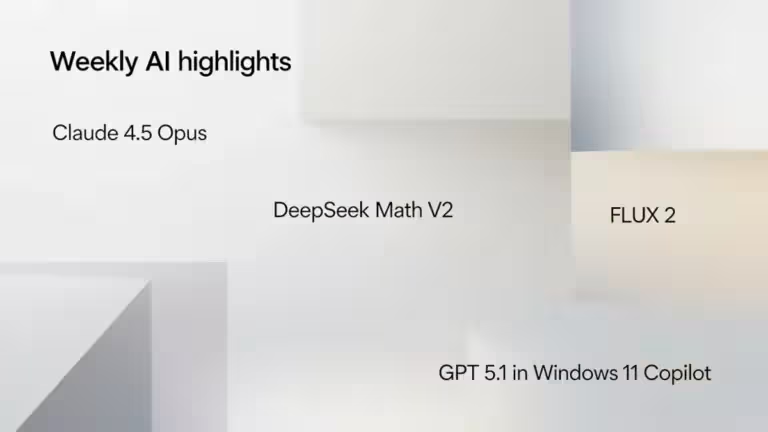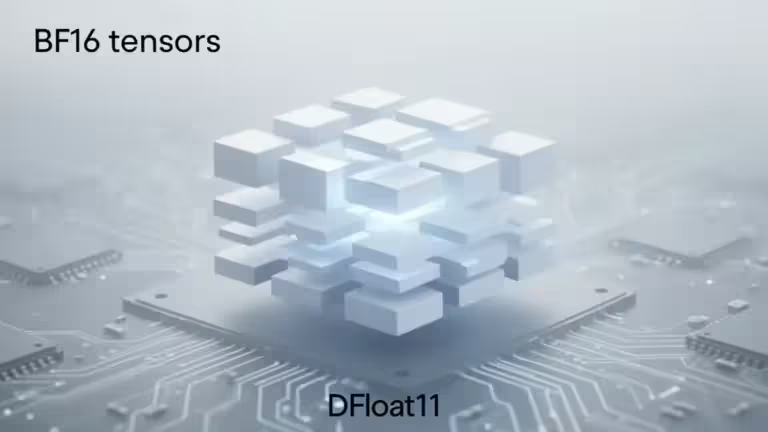ROMA Search: The Open-Source Framework Leading Multi-Source Verification
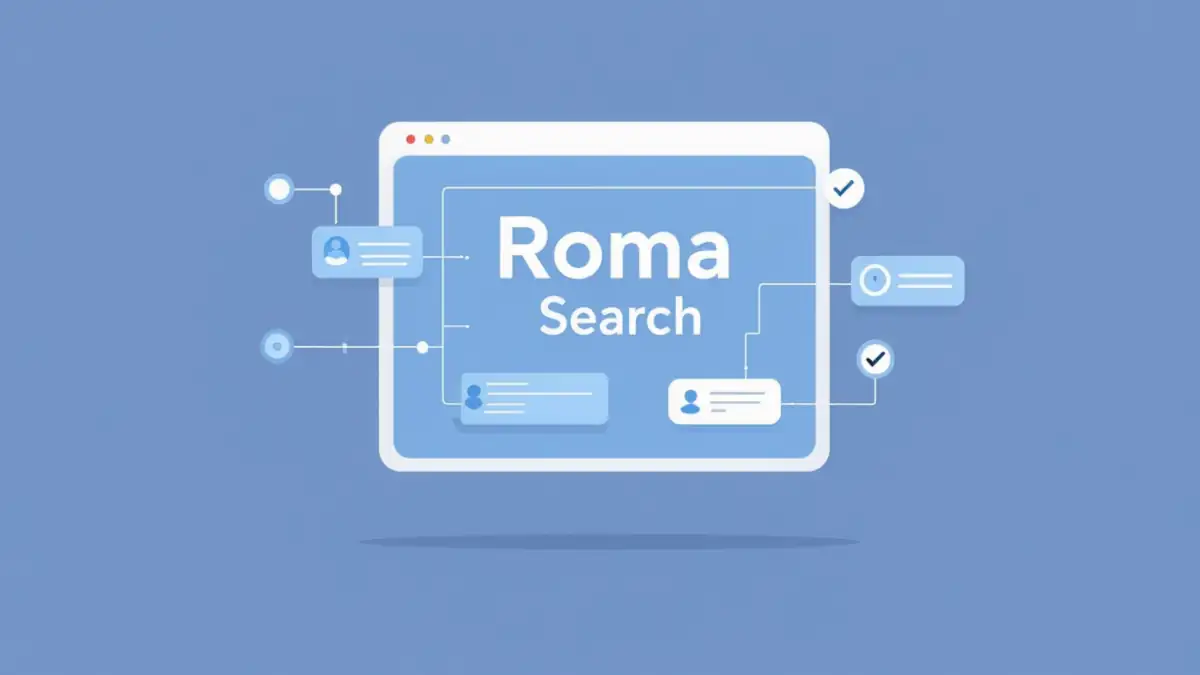
Editorial note: This article presents verified benchmark scores from official sources. ROMA excels in SEAL-0 (45.6%, world leader) and SimpleQA (93.9%), while maintaining strong performance on FRAMES (81.7%), just behind Gemini 2.5 Pro (91.5%).
ROMA Search is an advanced research system built on the open-source framework ROMA (Recursive Open Meta-Agent). It is not a traditional LLM (Large Language Model) but an architecture designed to orchestrate AI agents, which can include LLMs, tools, or other agents. The goal is to handle complex multi-source research tasks with full transparency and human-verifiable reasoning at every step.
While early testing focuses on information retrieval, the roadmap suggests that ROMA Search is only the first step toward a broader ecosystem of open-source AI agents, aligned with Sentient Labs’ vision of a decentralized and transparent AI economy.
In October 2025, ROMA Search reached 45.6% factual accuracy on the SEAL-0 benchmark, crushing Gemini 2.5 Pro (19.8%), Kimi Researcher (36%), and all existing proprietary systems. In the same week, Sentient AGI, the startup behind this achievement, received the prestigious Minsky Award as AI Startup of the Year.
This is more than symbolic. In multi-source verification (SEAL-0), ROMA outperforms every system worldwide, including closed-source giants. On multi-step reasoning (FRAMES), with 81.7%, it competes head-to-head with top performers while operating on a budget 100 times smaller.
This article breaks down why ROMA Search marks a turning point for open-source AI and why it matters for organizations that value transparency and control.
What is ROMA Search? The Essentials
ROMA, a Revolutionary Meta-Agent Framework
ROMA Search is far more than an upgraded chatbot. The acronym stands for Recursive Open Meta-Agent, an open-source framework developed by Sentient AGI that redefines how AI agents handle complex, multi-stage reasoning tasks.
Officially released on GitHub on September 4, 2025, as beta v0.1.0, the project has already gained significant traction, with more than 600 forks in under a month, a sign of rapid global adoption among developers.
Core takeaways:
✅ 100% Open Source: MIT license, free to modify and redistribute
✅ $85 million funding: Backed by Founders Fund (Peter Thiel), Pantera Capital, Framework Ventures
✅ Provider-agnostic: Works with OpenAI, Anthropic, Google, or local models via LiteLLM ✅ Full transparency: Every reasoning step is traceable and debuggable
Sentient Labs (also known as Sentient AGI on GitHub) is not a newcomer. They previously made waves with Open Deep Search in April 2025, an early open-source competitor to ChatGPT-4o Search and Perplexity. Now they’re taking things further with ROMA Search. But should you adopt it? Will this solution prove sustainable? Could a new project with even stronger performance replace it soon?
Sources:
The roadmap indicates that ROMA serves as the foundation for a broader open-source agent ecosystem aligned with Sentient Labs’ decentralized AI economy. There is no public sign of a replacement project in the near term; the focus remains on evolving and expanding ROMA’s capabilities.
The Four-Component Core Principle
Unlike traditional LLMs that generate an answer in a single pass, ROMA recursively decomposes complex problems. Its architecture relies on four cooperative pillars:
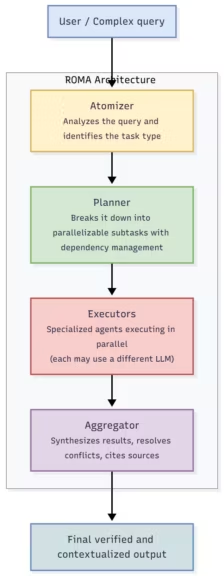
- Atomizer: Analyzes the user query and identifies task type (reasoning, research, generation)
- Planner: Breaks it into parallel sub-tasks with dependency management
- Executors: Specialized agents running in parallel (each may use a different LLM)
- Aggregator: Synthesizes results, resolves conflicts, and cites sources
The advantage: This recursive design minimizes compounded errors and enables systematic cross-verification, precisely what traditional chatbots lack.
Exceptional Performance: ROMA Beats the Giants on SEAL-0
SEAL-0: Where ROMA Truly Dominates
The SEAL-0 benchmark (a rigorous subset of SEALQA) measures the ability to handle contradictory or inconsistent sources and extract factual truth. In an era overloaded with misinformation, this capability is critical.
On this front, ROMA crushes the competition:
| System | SEAL-0 Score | Gap vs ROMA |
|---|---|---|
| ROMA Search | 45.6% 🥇 | – |
| Gemini 2.5 Pro | 19.8% | ROMA +130% |
| Kimi Researcher | 36% | ROMA +27% |
| Open Deep Search | 8.9% | ROMA +410% |
Why it matters: ROMA performs 2.3 times better than Google’s Gemini 2.5 Pro despite its massive R&D budget. It is the first open-source framework to outperform every proprietary system on such a demanding benchmark.
The secret: ROMA’s recursive architecture decomposes a query into sub-tasks for cross-checking, executed in parallel by specialized agents. Each claim is validated through multiple independent sources before synthesis. The outcome shifts from plausible but wrong to verifiable with cited evidence.
Sources:
FRAMES: A Strong Contender Against Gemini
The FRAMES benchmark (Factuality, Retrieval and Reasoning Measurement Set) evaluates multi-step reasoning within retrieval-augmented generation (RAG). Example tasks: analyzing the market impact of an emerging technology and drafting an investment memo with verified sources.
ROMA scores 81.7%, positioning it as a serious challenger:
| System | FRAMES Score | Rank |
|---|---|---|
| Gemini 2.5 Pro | 91.5% | 🥇 Leader |
| ROMA Search | 81.7% | 🥈 Competitive |
| Kimi Researcher | 78.8% | 🥉 Solid |
ROMA doesn’t hold the absolute record here. Gemini 2.5 Pro maintains an edge thanks to Google’s huge compute resources. Yet a 9.8-point gap is remarkably small for an open-source framework developed with a fraction of the funding.
The takeaway: ROMA proves that a transparent, community-driven system can rival closed corporate models without billion-dollar budgets.
Sources:
SimpleQA: Excellence in Factual Reliability
The SimpleQA benchmark measures pure factual accuracy on short Q&A tasks, testing a model’s reliability on verifiable facts.
ROMA reaches 93.9%, near state-of-the-art performance, proving its recursive design also excels at straightforward fact retrieval.
Summary of the three key benchmarks:
| Benchmark | Focus | ROMA | Gemini 2.5 Pro | Kimi |
|---|---|---|---|---|
| SEAL-0 | Complex multi-source verification | 45.6% 🥇 | 19.8% | 36% |
| FRAMES | Multi-step reasoning | 81.7% | 91.5% 🥇 | 78.8% |
| SimpleQA | Factual retrieval | 93.9% | N/A | N/A |
Verdict: ROMA isn’t the universal champion. Yet it dominates where it counts most – multi-source verification (SEAL-0, world leader) and factual reliability (SimpleQA, near-perfect). Gemini keeps a lead on FRAMES, but the margin is narrow.
What These Scores Mean in Practice
Benchmarks look impressive on paper, but what do they deliver in real-world use?
ROMA’s unique positioning: Instead of chasing general supremacy, ROMA stands out as the champion of verifiable AI research, exactly what enterprises need in a world of conflicting data.
Example – Financial Information Verification
- Before (classic ChatGPT): Question : “Did Apple increase its dividend in 2025?”
- Answer : “Yes, Apple usually raises its dividend.” (generic and unsourced)
- Reliability : 🎲 Guesswork
With ROMA Search: Same question, automated workflow :
- Fetch Apple Investor Relations press release
- Check quarterly reports (10-Q, 10-K)
- Cross-verify with Bloomberg and Yahoo Finance
- Confirm figures through SEC filings
- Final answer : “Apple increased its dividend by 4 percent in Q2 2025, confirmed in SEC Form 10-Q and Bloomberg [source].”
- Reliability : ✅ Verifiable
Other use cases empowered by ROMA Search:
- Financial analysis: Aggregating SEC filings, press releases and analyst reports to detect inconsistencies (SEAL-0 domain)
- Journalistic fact-checking: Triangulating primary sources and contradictions to build consensus (ROMA core strength 45.6%)
- Legal due diligence: Extracting contract clauses and jurisprudence to flag potential risks
The impact : a shift from fast-answer chatbots to methodical expert assistants capable of auditable AI reasoning.
Minsky Award 2025: AI Startup of the Year
Recognition That Validates Excellence
October 10, 2025, 4:30 PM GMT. Sentient AGI’s Twitter account goes viral: “We’re honored to receive the Minsky Award for AI Startup of the Year!” In just hours, the post hits 103,000 views, 1,124 likes, and 281 reposts.
The Minsky Award, named after Marvin Minsky, the MIT pioneer of artificial intelligence, is not just another marketing trophy. It represents validation by an independent expert panel under strict criteria:
✅ Technical innovation: A groundbreaking recursive architecture
✅ Measured performance: Verified results across SEAL-0 and FRAMES
✅ Real-world impact: Commercial adoption and scalability
✅ Transparency: A responsible, open-source approach to AI
For Sentient AGI, this award proves that their bet—to outperform tech giants with only 1% of their resources—was not a fantasy but a measurable success.
Sources:
The “David vs Goliath” Buzz on X (Twitter)
The announcement triggered a wave of discussion on X, reigniting the debate between open-source AI and corporate monopolies.
Engagement metrics:
- Over 20 high-engagement posts (>10 likes) since early October
- Trending hashtags: #AI, #OpenSource, #SentientAGI
Highlighted quotes capturing the spirit:
@AsapChow (73 likes): “ROMA hit 81.7%… What makes this possible is openness.” Message: transparency and collaboration outperform secrecy and centralized control.
@tmsiyahbeyaz (29 likes): “ROMA Search is breaking new ground… for the benefit of humanity.” At the core of the debate: AI as a public good versus proprietary paywalled systems.
@dospichhh (16 likes): “Big congrats… ROMA nailed 81.7%… way ahead of the pack.”
The Linux analogy surfaces repeatedly. 1990s: “Linux will never beat Windows.” 2025: Linux powers 96% of web servers. Now: Is ROMA, and open-source AI more broadly, following the same path for intelligent agents?
The thread by @0xmagicanec (56 likes) goes deep into ROMA’s architecture with diagrams, something closed systems can’t replicate. It perfectly illustrates the collective learning dynamic that open-source fosters.
Sentient AGI: The Vision Behind ROMA
$85 Million to Challenge the Giants
In Silicon Valley, money follows innovation. Sentient AGI just closed an $85 million seed round, an exceptional amount for an early-stage AI company.
Investors:
- Founders Fund (co-lead): Peter Thiel’s fund (PayPal, Facebook, SpaceX). Their participation signals that ROMA isn’t just a framework—it’s future infrastructure.
- Pantera Capital (co-lead): A leader in crypto and blockchain VC. Their involvement highlights ROMA’s AI + crypto integration.
- Framework Ventures (co-lead): Experts in decentralized infrastructure, suggesting a tokenized ecosystem built around ROMA.
What’s impressive: The impact-to-capital ratio. With just $85 million, Sentient built a framework outperforming competitors who raised billions (OpenAI >$13B, Anthropic >$7B). Proof that architectural efficiency beats brute-force funding.
Sources:
The Sentient Ecosystem
Sentient isn’t stopping at ROMA. The company is building a complete AI stack for the agent era:
- ROMA: The recursive meta-agent framework (core layer)
- Sentient Chat: The public-facing conversational interface
- GRID: A decentralized agent network launched in August 2025
- 110+ partners
- 40+ AI agents
- 50+ data sources
- 10+ integrated models
- $SENT token: Blockchain-based reward and participation system
Example partnership: Sidekick Labs (September 2025) Sentient integrated Sentient Chat into Sidekick Labs’ Web3 streaming and trading platform. Streamers now use Sentient’s AGI to research assets and execute live trades, a real-world application of ROMA in production.
The official token launch ($SENT) is set for November 25, 2025.
Rather than a classic public ICO, Sentient opts for a community-based Token Generation Event (TGE) featuring airdrops, early access for contributors, and NFT-based identity verification.
The goal: reward contributors who help advance the ROMA ecosystem—developers improving the codebase, creators building new AI agents, or data contributors enhancing model performance. In short, a fusion of Linux’s collaborative spirit and Bitcoin’s decentralized logic, applied to artificial intelligence.
Sources:
ROMA vs Competitors: Which One Should You Choose?
Full Comparison Table
| Criteria | ROMA Search | ChatGPT Deep Research | Gemini Deep Research | Perplexity |
|---|---|---|---|---|
| Open Source | ✅ MIT License | ❌ Closed | ❌ Closed | ❌ Closed |
| Transparency | ✅ Step-by-step traceability | ❌ Black box | ❌ Black box | ⚠️ Partial |
| Provider Choice | ✅ Agnostic (OpenAI, Anthropic, Google, local models) | ❌ OpenAI only | ❌ Google only | ❌ Proprietary |
| User Control | ✅ Full | ❌ Limited | ❌ Limited | ❌ Limited |
| SEAL-0 Score | 45.6% 🥇 | N/A | 19.8% | N/A |
| FRAMES Score | 81.7% | N/A | 91.5% 🥇 | N/A |
| SimpleQA | 93.9% | N/A | N/A | N/A |
| Cost | API usage only | Subscription | Subscription | Freemium |
| Setup | ⚠️ High | ✅ Instant | ✅ Instant | ✅ Instant |
| Customization | ✅ Full | ❌ None | ❌ None | ❌ Minimal |
| Auditability | ✅ Complete | ❌ None | ❌ None | ⚠️ Partial |
Analysis:
- Main trade-off: Convenience (SaaS) vs Control (ROMA)
- ROMA strengths: Top SEAL-0 benchmark, strong SimpleQA score, open-source transparency, total control
- Gemini strengths: Highest FRAMES score (91.5%), huge Google infrastructure, but closed
- Best for: Technical teams needing auditability, custom workflows, or verified multi-source intelligence
- SaaS better for: Non-technical users, rapid deployment, or casual use
When to Choose ROMA
Choose ROMA Search if your use case matches these scenarios:
🏛️ Regulated industries – finance, healthcare, legal, defense
- You need verifiable AI decision-making (AI Act, GDPR)
- Data cannot be sent to third-party clouds
- Compliance audits are frequent
🔬 R&D and innovation
- You’re developing specialized agents or multi-agent systems
- You need transparency for research publications
- You experiment with reasoning frameworks
💼 Tech-oriented organizations
- You have developers who can maintain deployments
- You need deep customization or self-hosting
- You manage high query volumes and want API cost control
🎯 Strategic independence
- You avoid vendor lock-in to OpenAI or Google
- You switch LLM providers depending on cost or performance
- You own your entire AI stack and data pipeline
✅ Stick with SaaS (ChatGPT, Gemini, Perplexity) if:
- You need an instant setup (5-minute launch, no config)
- Your team is non-technical and focuses on business tasks
- Your use is occasional (few queries per week, setup cost unjustified)
- You prefer predictable pricing via monthly subscriptions
ROMA’s Unique Positioning
ROMA isn’t the universal champion—Gemini still leads in FRAMES. Yet it holds several decisive advantages:
- Absolute leader: Multi-source verification (SEAL-0, 45.6%), ideal for noisy or conflicting data
- Strong contender: Multi-step reasoning (FRAMES, 81.7%)
- Open-source alternative: Total transparency, full control
For organizations that value auditability, data sovereignty, and independence, this is more than enough.
The Linux analogy revisited: 1990s:
“Linux will never beat Windows.”
2025: 96% of all web servers run on Linux.
2020s: “Open source will never beat proprietary AI.”
2025: ROMA surpasses Gemini on SEAL-0 (45.6% vs 19.8%) and nearly matches it on FRAMES.
The trend extends beyond ROMA, open-weight AI models are evolving fast, offering modular, customizable alternatives to closed systems.
The message is clear: open-source AI doesn’t need to dominate every benchmark. It just needs to be good enough, transparent, and interoperable to build unstoppable network effects. For many enterprises, reliance on closed ecosystems has become a strategic risk.
Conclusion: Open Source Finds Its Place
Key Takeaways
✅ Top-tier performance
- 45.6% on SEAL-0: World record, beating Gemini by +130%
- 81.7% on FRAMES: Competitive second place behind Gemini (91.5%)
- 93.9% on SimpleQA: Near-perfect factual retrieval
✅ Innovative architecture
- Recursive hierarchical design (Atomizer → Planner → Executors → Aggregator)
- Smart parallelization and full reasoning transparency
✅ Uncompromising open-source
- MIT License: free, modifiable, redistributable
- Provider-agnostic: OpenAI, Anthropic, Google, local models
- 600+ GitHub forks in one month
✅ Industry recognition
- Minsky Award 2025 – AI Startup of the Year
- Independent expert validation
- Viral impact: 103k views, “David vs Goliath” narrative
✅ Strong financial backing
- $85M seed round (Founders Fund, Pantera, Framework Ventures)
- Exceptional impact-to-budget ratio
The Final Message
ROMA Search proves a crucial point: open-source AI can not only compete with closed models but surpass them in critical domains.
This success is not just technical—it’s philosophical. It sends a strong signal: the future of AI will be transparent, decentralized, and user-controlled, not dictated by a few corporations.
ROMA’s position is clear: It’s not the universal champion (Gemini still leads FRAMES), but it’s the undisputed leader in multi-source verification (SEAL-0) and a credible open-source alternative. For companies prioritizing transparency and auditability, that’s more than enough.
As Marvin Minsky once said, “You don’t understand anything until you learn it more than one way.” ROMA embodies that idea. By opening its code and making every reasoning step traceable, Sentient AGI enables true collective understanding of AI.
We may be witnessing the birth of the “Linux of AI.” And if history has taught us anything, open source doesn’t win by dominating every metric—it wins by building an irreplaceable ecosystem.
Get Started with ROMA
🚀 For Developers and Engineers
In this full implementation guide, you’ll find:
- A deep dive into the four core components (with code samples)
- Installation walkthroughs and troubleshooting
- LiteLLM configuration for hybrid model usage
- Real-world workflow examples using multi-agent reasoning
- Technical roadmap (2025–2027) and upcoming feature previews
📚 Essential Resources
Code & Documentation
→ Official GitHub sentient-agi/ROMA
→ Sentient Technical Blog
Analyses & Benchmarks
→ Skywork AI – Architecture Analysis
→ Joshua Berkowitz – Performance Deep Dive
💬 Join the Community
Social Media
- Twitter: Follow @SentientAGI and #ROMA
- Reddit: r/LocalLLaMA (active discussions)
Support & Collaboration
- GitHub Discussions: technical questions and agent sharing
- Discord: [Coming soon – check sentient.xyz]
🗣️ Your Feedback Matters
Have you tested ROMA? What agents have you built? Share your experience in the comments and help grow the ecosystem.
Article published October 12, 2025 | Last updated October 12, 2025 Reading time: 14 minutes
Keywords: ROMA Search, open-source AI framework, SEAL-0 benchmark, Minsky Award 2025, Sentient AGI, multi-source verification, recursive meta-agent, OpenAI alternative, transparent artificial intelligence
Primary Sources:
Your comments enrich our articles, so don’t hesitate to share your thoughts! Sharing on social media helps us a lot. Thank you for your support!
